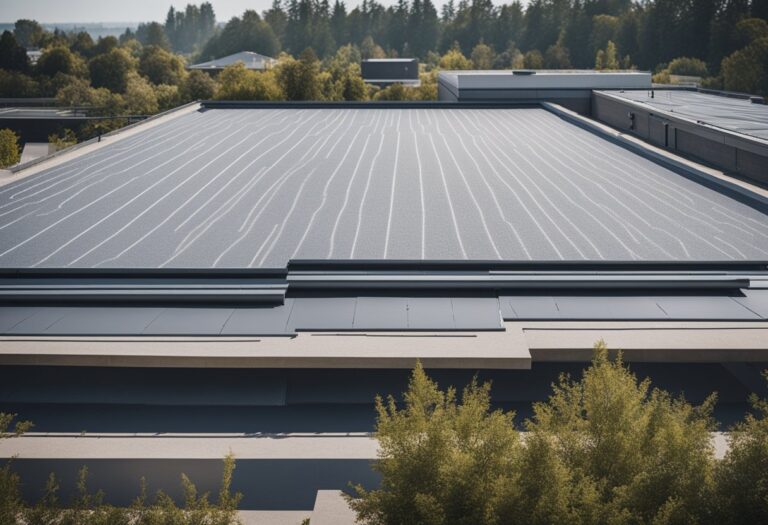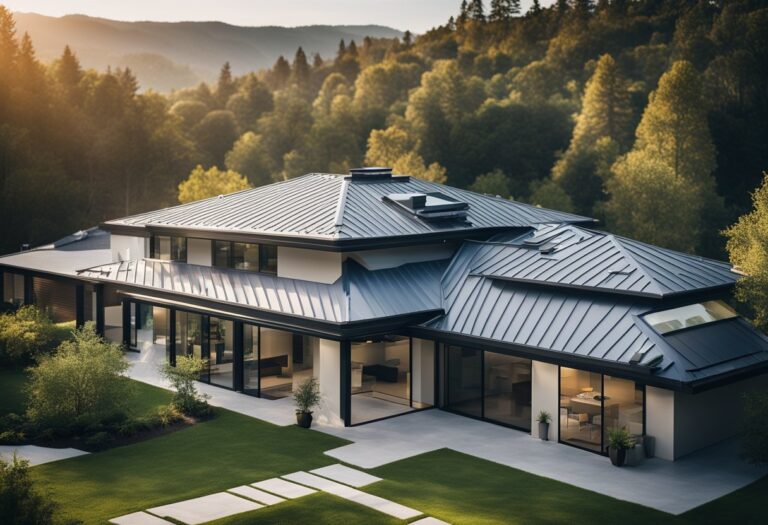Concrete tile roofs are a popular choice for homeowners who want a durable and long-lasting roofing material. Made from a mixture of cement, sand, and water, concrete tiles are known for their strength and ability to withstand harsh weather conditions. They are also energy-efficient, as they reflect sunlight and help keep homes cooler in hot weather.

One of the benefits of concrete tile roofs is their versatility. They come in a variety of styles, colors, and finishes, so homeowners can choose a look that complements their home’s design. Additionally, concrete tiles can be made to resemble other roofing materials, such as wood shake or slate, at a fraction of the cost. This makes concrete tile a popular option for homeowners who want the aesthetic of a high-end roofing material without the high price tag.
Concrete tile roofs are also relatively low maintenance, requiring only occasional cleaning to remove debris and prevent algae growth. However, it is important to note that concrete tiles may require structural reinforcement to support their weight, and they can be more difficult to install than other roofing materials. Homeowners should consult with a roofing professional to determine if a concrete tile roof is the right choice for their home.
Basics of Concrete Tile Roofing

Concrete tile roofing has become increasingly popular in recent years due to its durability, affordability, and aesthetic appeal. In this section, we will explore the materials and composition of concrete tile roofing, as well as its benefits and longevity.
Materials and Composition
Concrete tile roofing is made from a mixture of sand, cement, and water. The tiles are molded into various shapes and sizes and then cured to harden. They are available in a variety of colors and styles to match the design of any home.
Concrete tile roofing is a popular choice for homeowners who want a durable and long-lasting roofing solution. It is resistant to fire, wind, and hail, and can last up to 50 years with proper maintenance.
Benefits and Longevity
One of the biggest benefits of concrete tile roofing is its longevity. As mentioned above, it can last up to 50 years with proper maintenance. This makes it a cost-effective choice for homeowners who want to avoid the expense of frequent roof replacements.
Concrete tile roofing is also energy-efficient, as it helps to regulate the temperature of a home. This can result in lower energy bills and a more comfortable living environment.
In addition to its durability and energy efficiency, concrete tile roofing is also aesthetically pleasing. It can mimic the look of other roofing materials, such as clay or slate, at a lower cost.
Overall, concrete tile roofing is a reliable and stylish option for homeowners who want a long-lasting and cost-effective roofing solution.
Installation Process

Concrete tile roofs are a popular choice for homeowners due to their durability and longevity. Installing a concrete tile roof requires proper preparation, laying techniques, and finishing touches. In this section, we will go over the installation process for concrete tile roofs.
Preparation and Safety
Before starting the installation process, it is important to ensure that the roof deck is sound and able to support the weight of the tiles. The roof deck should be clean, dry, and free of any debris. A layer of underlayment should be installed over the roof deck to provide a moisture barrier and protect against leaks.
It is also important to take safety precautions during the installation process. Workers should wear appropriate safety gear, such as hard hats and non-slip shoes. They should also use safety harnesses and ropes when working on steep roofs.
Laying Techniques
Concrete tiles are typically laid in a staggered pattern, with each row offset from the row below it. This helps to ensure that the tiles are properly interlocked and provides better protection against wind and rain.
When laying the tiles, it is important to use the correct fasteners and spacing. The tiles should be secured to the roof deck using corrosion-resistant screws or nails. The spacing between the tiles should be consistent and in accordance with the manufacturer’s recommendations.
Finishing Touches
After the tiles have been laid, it is important to install ridge tiles and hip tiles to provide a finished look and protect against leaks. The ridge and hip tiles should be installed using mortar or another appropriate adhesive.
Finally, the installation process should be inspected to ensure that the tiles are properly secured and the roof is watertight. Any necessary repairs or adjustments should be made before the installation is considered complete.
Overall, the installation process for concrete tile roofs requires proper preparation, laying techniques, and finishing touches. By following these steps and taking appropriate safety precautions, homeowners can enjoy a durable and long-lasting roof for years to come.
Maintenance and Repair

Routine Upkeep
Concrete tile roofs are known for their durability and longevity. However, like any other roofing material, they require regular maintenance to ensure their longevity. Routine upkeep involves inspecting the roof at least once a year to identify any issues that may arise. Homeowners should look for cracked or broken tiles, loose or missing mortar, and any signs of water damage. Removing debris, leaves, and branches that may accumulate on the roof is also important. These can trap moisture and promote moss or algae growth.
Handling Damages
Even with proper maintenance, damages may still occur. When damages occur, it is important to handle them promptly to prevent further damage. Homeowners should hire a professional roofing contractor to handle any repairs or replacements. Repairing or replacing a single tile is relatively easy and inexpensive. However, if the damage is extensive, replacing the entire roof may be necessary.
It is important to note that homeowners should never attempt to repair or replace the roof themselves. Walking on a concrete tile roof can be dangerous and may cause further damage to the roof. Additionally, improper repairs may lead to leaks and other issues.
In conclusion, routine maintenance and prompt handling of damages are crucial to the longevity and performance of a concrete tile roof. Homeowners should be diligent in inspecting their roofs and hiring a professional roofing contractor for any repairs or replacements.
Design and Aesthetics

Concrete tile roofs are not only durable and long-lasting, but they also offer a wide range of design options that can greatly enhance the aesthetic appeal of a home. Concrete tiles come in a variety of colors, shapes, and textures, making them a versatile roofing material for any architectural style.
Color and Texture Options
One of the biggest advantages of concrete tile roofs is the wide range of color options available. Concrete tiles can be produced in almost any color and can be customized to match the specific color scheme of a home. Homeowners can choose from traditional earth tones, pastels, or multicolor blends to create a unique and personalized look for their roof.
In addition to color, concrete tiles also come in a variety of textures. Tiles can be smooth or rough, matte or glossy, and can even mimic the look of other materials such as wood or slate. The texture of the tile can greatly impact the overall look and feel of a roof, so it’s important to consider the texture when choosing a concrete tile roof.
Architectural Styles
Concrete tile roofs can be used on a variety of architectural styles, from traditional to modern. The tiles can be shaped to fit any roof pitch, making them a versatile option for any home.
For traditional homes, clay or terracotta-colored tiles can be used to create a classic, timeless look. On the other hand, modern homes can benefit from the sleek, clean lines of flat concrete tiles in a monochromatic color scheme.
Overall, concrete tile roofs offer homeowners a wide range of design options to enhance the aesthetic appeal of their home. With a variety of colors and textures to choose from, along with the ability to fit any architectural style, concrete tile roofs are a versatile and stylish roofing option.






